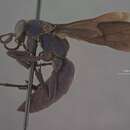Comprehensive Description
(
الإنجليزية
)
المقدمة من Memoirs of the American Entomological Society
Psorthaspis guatemalae Bradley
Psorthaspis guatemalae Bradley, 1944, Trans. Amer. Ent. Soc, 70: 43-44 [Type: 2, Guatemala: Trece Aguas, Alta Vera Paz, Nov. 1905 (G. P. Goll) (USNM, no. 57, 925)].
This species is distinctive because of its small size and the weak rugae on the propodeum. The male is described here for the first time.
Female. — Length 14 mm.; fore wing 11 mm. Black, pubescence reflecting green to violet; wings fuscous, violaceous. Clypeus truncate apically. Head 1.1 X as wide as high; MID .64 X TFD. POL:OOL= 17:23; posterior ocelli removed from vertex crest by slightly less than POL. Clypeo-frontal bridge narrow, acute, on same plane as clypeus and front. In frontal view, vertex convex from the corner of one eye to that of the other, except for a weak median concavity. Vertex depressed laterad of posterior ocelli, as in laevifrons. Propodeum with smoother contours than in laevifrons, and the rugae weaker than in that species. Claws with the outer ray rather strongly curved, nearly parallel to inner ray.
Plesiallotype. — $ , Mexico: Morelos: 4 mi. E of Cuernavaca, 18 June 1959, 6000 feet (HEE) [MCZ].
Description of plesiallotype male. — Length 8 mm.; fore wing 7 mm. Black, pubescence of body and legs brilliantly bluish, with some blue-green reflections; pubescence of face light brown. Clypeus, scape, front, and temples with rather long, dense, dark hairs; thorax, propodeum, coxae, and femora with abundant setae of moderate length; abdomen wholly clothed with sparse, erect or semierect setae, including the dorsum (in general, the body is considerably more hairy than in laevifrons, about the same as in eubule, less hairy than in bradleyi). Clypeus 1.6 X as wide as high, its apical margin evenly rounded. Head 1.15 X as wide as high; vertex elevated in an even arc between tops of eyes. MID .69 X TFD; UID 1.3 X LID; POL:OOL= 10:13; posterior ocelli removed from vertex crest by less than twice their own diameters. Antennae relatively short, segment three barely longer than thick, segments 4-12 each about 1.25 X as long as thick. Slope of propodeum rather low, slightly steeper on posterior third than anteriorly; sides of dorsum not humped; postero-lateral angles not at all prominent. Claws cleft, inner ray subacute except on inner front tarsal claws, where the inner ray is rounded, lobe-like. SGP keeled, elongate, tapering to a subacute apex (fig. 67). Parameres of genitalia not swollen apically, abruptly truncate; digiti with the setulae absent over most of the center and mesal surface of the disc (fig. 28).
Distribution. — Guatemala and southern Mexico. (Map 18.) Specimens examined. — 1 2,2 8 S . Guatemala: 1 2 , Trece Aguas [type, USNM]. Mexico: Morelos: 1 S , 4 mi. E Cuernavaca, June (HEE) [MCZ]; Veracruz: 1 $ , Jalapa, 28 Sept. 1961 Variation. — In the Jalapa male, antennal segments 4-12 are each about 1.4 X as long as thick, the SGP slightly less slender than figured.
- الاقتباس الببليوغرافي
- Evans, H.E. 1966. A Revision of the Mexican and Central American Spider Wasps of the Subfamily Pompilinae (Hymenoptera: Pompilidae). Memoirs of the American Entomological Society vol. 20. Philadelphia, USA

